Indoor Air Quality
With the rapid development of science and technology, humans have made significant improvements in their living environments. The widespread use of air conditioners has created comfortable indoor conditions with controlled temperature and humidity, but it has also led to indoor air quality issues, especially in air-conditioned rooms without a fresh air system. This can result in "sick building syndrome" and "building-related illnesses," along with various chemical allergies.
Symptoms of "sick building syndrome" include headaches, irritability, dry skin, nasal congestion, runny nose, watery eyes, and itching. "Building-related diseases" refer to health problems directly caused by specific airborne components. More severe cases include "legged group disease" and "hypersensitive pneumonia," which can even pose life-threatening risks.
Indoor air quality generally refers to how well certain elements in the air support human comfort and health within a specific environment. It reflects people's expectations for clean and safe indoor air, going beyond just temperature and humidity. As a result, there has been extensive research into improving indoor air quality.
The main pollutants and their sources in indoor air are as follows:
| Pollutant | Source of Pollution |
|---|---|
| Suspended particles | Burning, smoking, human activity |
| Tobacco smoke | Smoking behavior |
| Asbestos | Insulation materials |
| Radon and its decay products | Walls and foundations |
| Formaldehyde | Building materials, furniture |
| Volatile Organic Compounds (VOCs) | Paints, cleaning agents, construction materials |
| Carbon monoxide | Burning, smoking |
| Carbon dioxide | Burning, respiration |
| Microorganisms | Animals, human bodies |
| Allergens | Animals, hair, insects, pollen |
| Ozone | Modern office equipment |
There are many harmful substances in indoor air, often present at low concentrations that may not be detectable by smell. However, this does not mean they are harmless. People spend a significant amount of time indoors, and prolonged exposure to these low-level pollutants can lead to serious health consequences.
Ventilation is an effective way to remove indoor pollutants, but it has limitations. In today’s polluted environment, outdoor air quality is often poor, making ventilation energy-intensive. Localized pollution sources can be hard to identify, and standard filters only remove dust, not gases or bacteria. Advanced activated carbon filters offer better performance for low-concentration pollutants and bacteria, making them ideal for continuous air purification.
2. Development History and Classification of Activated Carbon
Activated carbon has been used for centuries. Ancient Egyptians used charcoal to treat wounds, and in 1773, Scherr scientifically proved its gas adsorption properties. By the 19th century, it was used in the sugar industry. During World War I, activated carbon gas masks were introduced for protection against chemical warfare. In the 1960s, fibrous activated carbon was developed with unique properties. Today, research focuses on its structure, pore characteristics, and adsorption mechanisms.
Activated carbon comes in various forms, including powdered, granular, and fibrous types. Fibrous activated carbon, developed from carbon fibers, offers high surface area and fine texture. It can be made from coal, plant materials, petroleum, or plastics. Classified by use, it is mainly applied in gas-phase adsorption, requiring well-developed micropores.
3. Structure and Properties of Activated Carbon
Activated carbon has a complex structure composed of hexagonal carbon layers arranged irregularly. These layers create micropores, mesopores, and macropores. Micropores (<2 nm) make up most of the surface area and are crucial for adsorption. The presence of heteroatoms like oxygen and hydrogen enhances adsorption, particularly for polar molecules.
| Pore Type | Pore Diameter (nm) |
|---|---|
| Microporous | <2.0 |
| Intermediate Pores | 2.0 to 50 |
| Macropores | >50 |
Physical and chemical adsorption processes occur simultaneously. Physical adsorption is reversible, while chemical adsorption is stronger and more selective. The adsorption mechanism involves diffusion, internal movement, and surface binding, with factors like temperature and pore size affecting efficiency.
4. Adsorption and Filtration Mechanism of Activated Carbon
Adsorption involves the accumulation of substances on the surface of activated carbon, while filtration removes them from the air. Activated carbon acts as both an adsorbent and a filter, effectively removing harmful gases and particulates.
Physical adsorption relies on molecular attraction, while chemical adsorption involves bonding between the adsorbate and the surface. Key steps include boundary layer diffusion, internal diffusion, and surface adsorption. The effectiveness depends on pore size, temperature, and the nature of the pollutants.
| Physical Adsorption | Chemical Adsorption |
|---|---|
| Can't exceed the boiling point of the adsorbate | Independent of the boiling point |
| Fast and non-selective | Slower and highly selective |
| Multi-layer adsorption | Monolayer adsorption |
In practice, both mechanisms often occur together. For optimal performance, activated carbon must balance adsorption capacity and speed, ensuring efficient removal of pollutants under dynamic conditions.
5. Adsorption and Filtration of Activated Carbon on Indoor Gases
Activated carbon effectively removes volatile organic compounds (VOCs), odors, and harmful gases like CO, NO2, and SO2. It can also adsorb ozone and heavy metal ions such as arsenic, lead, and mercury.
It traps cigarette smoke particles through physical and chemical interactions, reducing indoor pollution. Its large surface area and porous structure allow it to retain small particles and adsorb gases efficiently.
6. Conclusion
Through this discussion, we’ve explored the history, structure, and application of activated carbon in improving indoor air quality. It is an effective solution for odor removal, sterilization, and pollutant elimination, offering a sustainable alternative to traditional ventilation systems.
To enhance its performance, researchers focus on optimizing filter design and material selection, especially using activated carbon fiber for its high adsorption capacity and speed. Despite its benefits, the cost of activated carbon filters remains a challenge for wider adoption.
If costs can be reduced and targeted removal of specific pollutants improves, activated carbon filters could become a key component in future air purification technologies, providing cleaner and healthier indoor environments.
24HR Electronic timer socket with photocell.
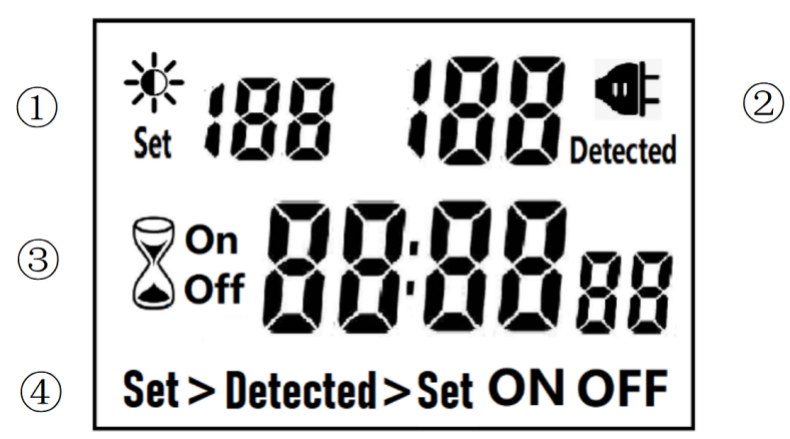
â‘ Light intensity setting
â‘¡ Light intensity detection
â‘¢ Countdown Timer ON & OFF
â‘£ 4 MODES:
Set > Detected: When the light intensity detection value is less than the set value, switch ON or OFF.
Detected > Set: When the light intensity detection value is greater than the set value, switch ON or OFF
ON : Always ON
OFF : Always OFF
NOTED:
1. The light intensity displayed by this machine is not the standard light intensity value (Lux), only the relative light intensity value.
2. The light intensity value is affected by the placement position and direction. Please determine the position first and then set it according to the actual light intensity detected. If you change the position or change the orientation, you need to reset the light intensity setting value suitable for the new position.
3. This product has built-in rechargeable battery. If it is not connected to AC for a long time, you need to connect the power supply to charge until the LCD can display normally.
MANUAL OPERATION
1. Press [UP" or [DOWN" to set the LUX value.
2. Press the [SET" key to start setting, and the P1 settable items will be flashed.
3. Press [UP" or [DOWN" to adjust the value.
4. Press [SET" key again to exit setting or enter next setting for countdown timer.
5. Repeat the [SET" key to start setting, and the P2 & P3 settable items will be flashed.

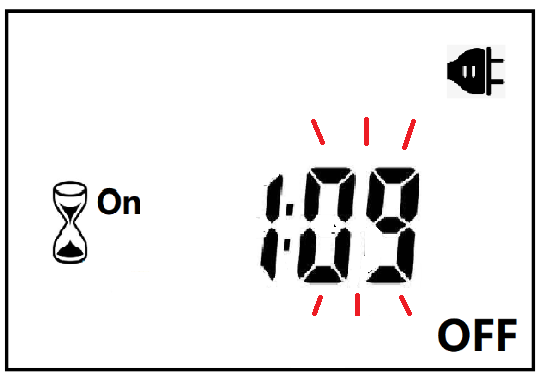

6. Press the [FUN" key to switch the working state in the following:
Set > Detected -> Detected > Set -> ON -> OFF
Set > Detected: Automatically switches when the detected ambient light intensity is darker than the set value
Detected >Set: Automatically switch when the detected ambient light intensity is brighter than the set value
When the brightness meets the setting conditions, the countdown starts as below:
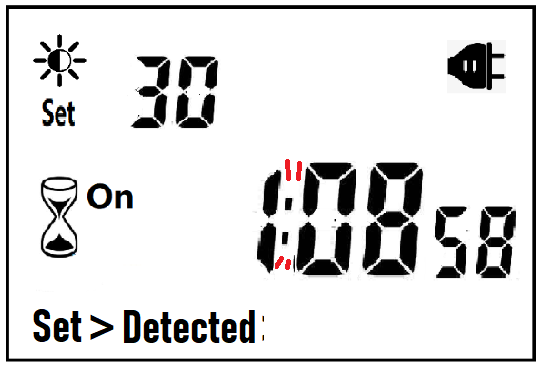
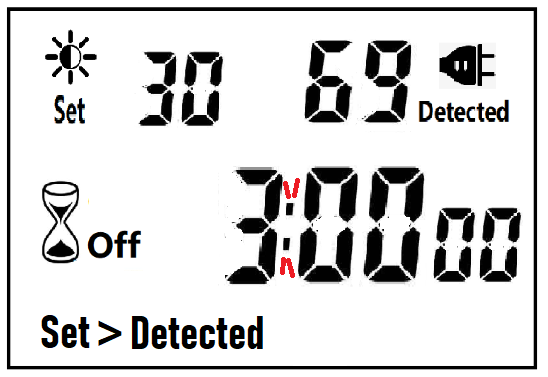
Note:when the countdown is ON, the detected value is not displayed.
When the brightness does not meet the setting conditions, the countdown stops and waits:
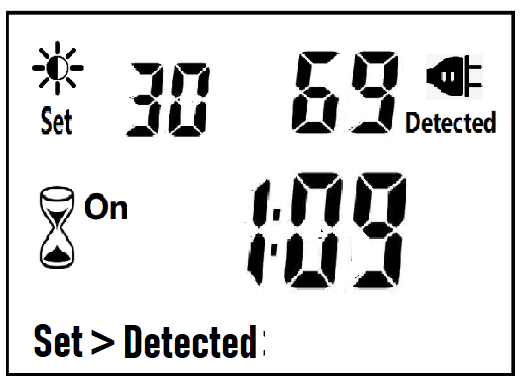
After the countdown ON is reduced to 0, the countdown OFF starts immediately and the power is OFF.
After the countdown OFF is reduced to 0:
A. If the light intensity meets the set conditions, a new round of countdown will be started;
B. If the light intensity does not meet the set conditions, keep the power off and wait for the light to meet the conditions before turning on automatically.
NOTE:
1. If the power is cut off while the countdown is running, the countdown will be terminated immediately and the relay output will be off. After the power is turned on again, a new round of brightness detection will start.
2. Modifying the brightness value in the countdown operation will not affect the current countdown operation. After the off time of the current countdown, the new brightness setting value will take effect.
3. In the countdown on operation, change the setting value of the countdown on, this countdown will still be timed according to the original setting value; the new setting value will take effect when the next countdown on starts.
4. In the countdown off operation, change the setting value of countdown off, this countdown will still be timed according to the original setting value; the new setting value will take effect when the next countdown off is started.
NOTE: the brightness setting value, countdown ON or countdown OFF, any one of which is equal to 0, cannot be switched ON or OFF automatically.
Manual Control
When ON or OFF is displayed, it means that the power supply remains ON or OFF, as shown in the figure below:

Power Detection and Standby Mode
With AC power supply, the icon ![]() lights up and works normally.
lights up and works normally.
When there is no AC power supply, the icon ![]() goes out, the brightness is not detected at this time, and the system enters the standby mode.
goes out, the brightness is not detected at this time, and the system enters the standby mode.
Photocell Timer, Photocell Timer Socket, Photocell Sensor, Photocell Sensor Socket, Sensor Plug, Sensor Switch Socket, Digital Photocell Timer, Digital Sensor Timer
NINGBO COWELL ELECTRONICS & TECHNOLOGY CO., LTD , https://www.cowellsockets.com